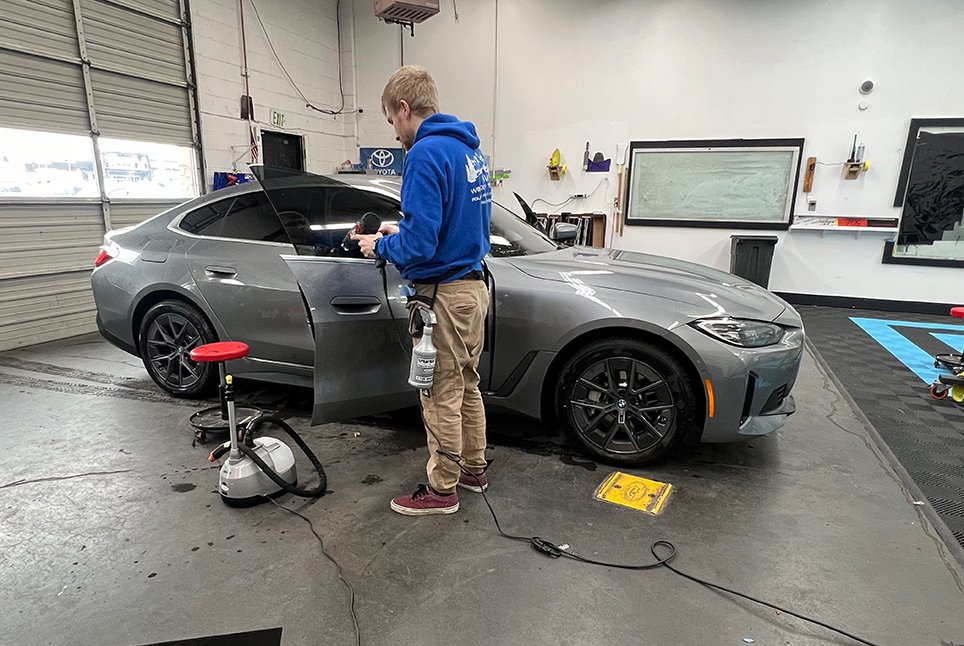Vehicle Window Tinting: A Guide to Picking the Perfect Color
Vehicle Window Tinting: A Guide to Picking the Perfect Color
Blog Article
Home Window Tinting Rules and Standards: What You Need to Know Prior To Tinting Your Vehicle
Prior to proceeding with window tinting for your lorry, it is important to acquaint on your own with the diverse legislations and guidelines that regulate this practice across various states. These policies determine the permitted degrees of color darkness, frequently gauged by visible light transmission (VLT) portions, and consist of details terms for front windshields targeted at ensuring road security. Additionally, certain territories might use clinical exemptions for people with certifying problems. Comprehending these complexities can conserve you from possible lawful ramifications, but what are the details regulations in your state?
Summary of Home Window Tinting Rules
Window tinting regulations are regularly based on variation across various jurisdictions, reflecting local policies and safety and security factors to consider. These legislations dictate the acceptable levels of tint darkness and reflectiveness on vehicle windows, making sure that chauffeurs preserve appropriate presence while also safeguarding against hazardous UV rays and heat.
The majority of laws classify window tinting based upon the Visible Light Transmission (VLT) percent, which shows the quantity of light that can travel through the home window. Usually, lower VLT percents represent darker tints. Legislations commonly set apart between the front, side, and back windows, with stricter constraints related to the front windscreen to improve security for both the vehicle driver and various other road customers.
Furthermore, some jurisdictions impose constraints on the reflectivity of the tint, preventing too much glare that could harm presence. Exemptions to these legislations might exist for people with particular clinical conditions needing additional sunlight defense. Compliance with window tinting regulations is essential, as offenses can lead to penalties, obligatory elimination of the tint, and potential boosts in insurance coverage premiums. For that reason, it is essential for automobile proprietors to familiarize themselves with neighborhood regulations before continuing with home window tinting installations.
State-by-State Color Laws
Comprehending the details window tinting regulations in each state is vital for car owners seeking to adhere to the regulation. Each state in the united state has actually developed its very own collection of regulations governing home window tinting, which can vary dramatically. These policies usually determine the permitted levels of tint darkness, the kinds of home windows that can be tinted, and any kind of clinical exceptions that might apply.
For circumstances, states like The golden state have rigid limitations on tint darkness for front windows, while others, such as New Mexico, might enable darker colors. Furthermore, specific states mandate specific presence portions for various windows, consisting of the windshield, front side windows, and back windows. It is critical for auto proprietors to acquaint themselves with their state's legislations to prevent prospective penalties or penalties.
Moreover, some states might need an accreditation sticker to be put on colored windows, showing compliance with state regulations. Failing to stick to these regulations not only takes the chance of lawful consequences but can also influence safety and security and exposure while driving. Consequently, automobile owners should perform thorough study or seek advice from neighborhood authorities to make sure full understanding and conformity with state-by-state tint policies.
Allowed Color Levels and Kinds
Many automobile owners might be amazed to discover that enabled color levels and kinds vary widely throughout various states. Each state has established its very own regulations relating to the acceptable darkness and reflectivity of home window tint, frequently gauged by Visible Light Transmission (VLT) percents. VLT refers to the amount of light that can travel through the colored home windows; therefore, a reduced percentage indicates a darker tint.

Additionally, the kinds of tint materials allowed can differ, with some states prohibiting metallic or mirror-like coatings. It is vital for vehicle owners to familiarize themselves with their state's certain legislations to make sure compliance. Non-compliance can result in penalties, required elimination of the tint, or various other lawful consequences, making it critical to comprehend these guidelines before waging installment.
Medical Exceptions for Tinting
While not all states supply allowances for medical exceptions pertaining to home window tinting, those that do recognize the requirement for particular individuals to enhance presence and convenience as a result of clinical problems. Different medical problems, such as lupus, skin cancer, and particular eye disorders, can provide individuals particularly sensitive to sunshine. As a result, these people might require darker colors to protect themselves from damaging UV rays and glow.

It is very important to keep in mind that despite having a medical exception, there may still be constraints on the level of tint allowed. Conformity with state laws makes certain that individuals are both secured and within lawful limits. Those thinking about clinical exceptions ought to call their local Division have a peek at these guys of Motor Autos or equivalent authority to comprehend the treatments and requirements needed to look for an exemption successfully.
Penalties for Non-Compliance
Falling short to abide by window tinting regulations can result in considerable charges, which differ by state. Police are encouraged to provide citations for lorries that do not follow the specified tinting guidelines. These penalties typically include fines, which can vary from modest amounts to several hundred dollars, depending on the severity of the infraction and the state concerned.
In some territories, repeated offenses may cause escalating fines or extra fines, such as required court looks. Additionally, non-compliance might require the elimination of unlawful tinting, commonly at the owner's cost. In extreme cases, regular offenders might deal with suspension of their vehicle enrollment till conformity is accomplished.
Furthermore, insurance coverage effects may develop from receiving numerous citations for window tint violations. Insurance companies might watch such infractions as a sign of riskier behavior, possibly causing boosted costs or problem in insurance coverage.
To prevent these fines, it is vital for lorry proprietors to acquaint themselves with their local window tinting regulations and ensure that their lorry complies (Window Tinting). This positive method not just avoids legal implications but likewise advertises roadway safety and security
Conclusion

Most laws categorize window tinting based on the Visible Light Transmission (VLT) portion, which indicates the quantity of light that can pass with the window. Compliance with home window tinting guidelines is essential, as infractions can result in fines, mandatory elimination of the color, and possible boosts in insurance policy premiums.Recognizing the details window tinting regulations in this content each state is essential for vehicle owners seeking to abide with the regulation. These laws usually dictate the permitted levels of tint darkness, the types of windows that can be tinted, and any kind of clinical exemptions that might use.
For instance, i thought about this states like California have strict limitations on tint darkness for front home windows, while others, such as New Mexico, may enable darker colors.
Report this page